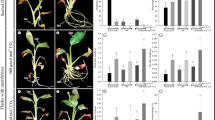Summary
Pure and mixed cultures of the dicotyledons Atriplex hortensis L. (C3 plant) and Amaranthus retroflexus L (C4) on the one hand and of the grasses Avena sativa L (C3) and Panicum miliaceum L. (C4) on the other hand were maintained in a standard soil with different ground water tables. After 12 weeks the length, dry weight and nitrogen-content of the aboveground and belowground parts of the plants, and in addition the carbon-and ash-content and the δ13C value of the aboveground parts were determined. It turned out that the length and the dry weight of the shoots of the C3 species showed on increasing tendency with increased water supply, while the values of the C4 species were drastically diminished at the highest water level only. The roots showed in most cases an increased length and dry weight at drier conditions, more pronounced in the C4 than in the C3 species. The nitrogen content of the shoots was mostly higher in the shoots of the C3 plants and in the roots of the C4 plants; it changed in a non-regular manner with variations in water supply. Since the carbon content did not change markedly, the C/N ratio was variable. There was a slight tendency for a higher carbon content and mostly also for a higher C/N-ratio in the shoots of C4 plants. The δ13C values of both C3 as C4 plants were in general not at all influenced by the water supply; they were fixed genetically. The ash content of the analyzed species did not show a clear relationship to the type of photosynthetic CO2-fixation or to the water regime.
The influence of light intensity was studied with mixed cultures of all four plant species, again with different water supply. There was a strong effect of light intensity on the competitive behaviour of the C3 and C4 plants under modified water conditions. The wild C3 plant Atriplex hortensis was most successful under conditions of relatively low light intensity and high water availability, while the cultivated ‘artificial’ species Avena sativa showed much less differences between full-light grown and shadow plants. The C4 plant Amaranthus retroflexus is most successful under competitive conditions at high water stress in full light. The C4 grass Panicum miliaceum showed maximum shoot growth in light, but was successful under competitive conditions especially also with good water supply. The light intensity had no effect on the δ13C values. — There was no indication that the soil-type as such has a distinct influence on the success of C3 or C4 plants in mixed cultures.
Similar content being viewed by others
References
Björkman O (1973) Comparative studies on photosynthesis in higher plants. In: Photophysiology, Vol. 8 A Giese (ed). Academic Press, New York London, pp 1–63
Clayton WD (1975) Chorology of the genera of Gramineae. Kew Bull 30:111–132
Cooper JP (1965) The evolution of forage grasses. In: Essays in crop plant evolution. J Hatchinson (ed), Cambridge University Press, Cambridge, pp 142–165
Doliner LH, Jolliffe PA (1979) Ecological evidence concerning the adaptive significance of the C4 dicarboxylic acid pathway of photosynthesis. Oecologia (Berl) 38:23–34
Downton WJS, Tregunna EB (1968) Carbon dioxide compensation — its relation to photosynthetic carboxylation reactions, systematics of the Gramineae, and leaf anatomy. Can J Bot 46:207–216
Gifford RM (1974) A comparison of potential photosynthesis, productivity and yield of plant species with differing photosynthetic metabolism. Aust J Physiol 1:107–117
Hatch MD, Osmond CB, Slatyer RO (1971) Photosynthesis and photorespiration. Wiley, Toronto
Hofstra JJ, Aksornkose S, Atmowidjojo S, Banaag JF, Santosa S, Sastrohoetomo RA, Thus LTN (1972) A study on the occurrence of plants with a low CO2 compensation point in different habitats in the tropics. Ann Bogor 5:143–157
Laetsch WM (1974) The C4 syndrome: a structural analysis. Ann Rev Pl Physiol 25:27–52
Mulroy TW, Rundel PW (1977) Annual plants: adaptation to desert environments. Bioscience 27:109–114
Osmond CB, Winter K, Ziegler H (in press) Functional significance of different pathways of CO2 fixation in photosynthesis. In: OL Lange, PS Nobel, CB Osmond, H Ziegler (eds), Physiological Plant Ecology. Encyclopedia of Plant Physiology (New Series). Springer, Berlin Heidelberg New York
Osmond CB, Ziegler H, Stichler W, Trimborn P (1975) Carbon isotope discrimination in alpine succulent plants supposed to be capable of Crassulacean acid metabolism (CAM) Oecologia (Berl) 18:209–217
Redmann RE (1975) Production ecology of grassland communities in western North Dakoty. Ecol Monogr 45:83–106
Rehder H (1976) Nutrient turnover studies in alpine ecosystems. I. Phytomass and nutrient relations in four mat communities of the Northern Calcareous Alps. Oecologia (Berl) 22:411–423
Rundel PW (1980) The ecological distribution of C4 and C3 grasses in the Hawaiian Islands. Oecologia (Berl) 45:354–359
Teeri JA, Stowe LG (1976) Climatic patterns and the distribution of C4 grasses in North America. Oecologia (Berl) 23:1–12
Tieszen LL, Senyimba MM, Imbamba SK, Troughton JH (1979) The distribution of C3 and C4 grasses and carbon isotope discrimination along an altitudinal and moisture gradient in Kenya. Oecologia (Berl) 37:337–350
Welkie GW, Caldwell MM (1970) Leaf anatomy of species in some dicotyledon families as related to the C3 and C4 pathways of carbon fixation. Can J Bot 48:2135–2146
Author information
Authors and Affiliations
Additional information
Dedicated to Prof. Dr. M. Evenari, Jerusalem, and to Dr. K.F. Springer, Heidelberg
Rights and permissions
About this article
Cite this article
Öztürk, M., Rehder, H. & Ziegler, H. Biomass production of C3- and C4-plant species in pure and mixed culture with different water supply. Oecologia 50, 73–81 (1981). https://doi.org/10.1007/BF00378796
Received:
Issue Date:
DOI: https://doi.org/10.1007/BF00378796




